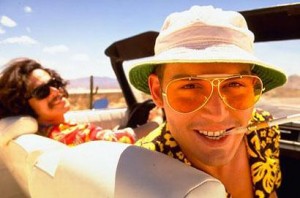
JOHNNY DEPP READS HUNTER S. THOMPSON
part 1. http://youtu.be/1jUxjhSSOnY
part 2 http://youtu.be/ZHiyVia9-_o
part 3 http://youtu.be/zfueZ7ZtOqc
Hunter S. Thompson and Johnny Depp: Partners in Film and Life
March 05, 2012 | by: Christopher Burns
Thompson and Depp
Thompson and Depp
Johnny Depp and Hunter S. Thompson first met in 1994 at the Woody Creek Tavern, instantly connecting as sons of the great state of Kentucky. Little did they know that this meeting would lead one of the most dynamic author/actor relationships Hollywood has seen since Arthur Miller and Marilyn Monroe. The checkered youths of both Depp and Thompson brought them close together during that first meeting in 1994, and they became best friends nearly instantly.
“You could strike sparks anywhere. There was a fantastic universal sense that whatever we were doing was right, that we were winning. . . .
Hunter S. Thompson and Johnny Depp
And that, I think, was the handle—that sense of inevitable victory over the forces of Old and Evil. Not in any mean or military sense; we didn’t need that. Our energy would simply prevail. There was no point in fighting—on our side or theirs. We had all the momentum; we were riding the crest of a high and beautiful wave. . . .
So now, less than five years later, you can go up on a steep hill in Las Vegas and look West, and with the right kind of eyes you can almost see the high-water mark—that place where the wave finally broke and rolled back.”
-Hunter S. Thompson in Fear and Loathing in Las Vegas
Thompson was born in Louisville, Kentucky in 1937, the son of a World War One veteran who died when he was 15. His mother sunk into a deep alcoholic state following his father’s death, and was described as a heavy drinker for some time. After being arrested and forced into the Air Force for a short time to avoid jail, Thompson began a career in journalism.
Like Thompson, Depp had a interesting high school experience, and never ended up graduating. He dropped out of high school to pursue a career as a Rock musician only to return two weeks later requesting re-admittance. Instead, the principal encouraged him to follow his dreams and Depp took off for Los Angeles, where he would eventually become a teen idol on the show 21 Jump Street.
Thompson, Depp, John Cusack, Inflatable Sex Doll
Professionally, both men were never afraid to push the boundaries of art and information. Thompson’s most amazing skill was capturing the air of excitement surrounding any great event, often using less that literal prose to do so. He was more than content taking cues from great journalists like Ernie Pyle, as well as from the literary icons he and Depp so adored, such as Ernest Hemingway and F. Scott Fitzgerald. In fact, he was fired as a copy boy at Time magazine for wasting time rewriting the Great Gatsby over and over again in order to understand how it felt to write a great novel.
This style became known as Gonzo journalism, and was credited as one of the most pioneering styles of reporting in the 20th century. Much more suited to a feature book or magazine, Gonzo is an often rambling form of writing which explores both the apparent and implicit side of the reported events.
While his lifelong reporting on President Nixon was less than factually precise: “Ford, who believes strongly in Heaven and Hell, has told more than one of his celebrity golf partners that ‘I know I will go to hell, because I pardoned Richard Nixon.’” His reporting spoke for a generation of Americans with a great disdain for the authority which continually betrayed them.
In Thompson’s semi-fictional accounts, the American public found a voice which transcended the black and white truth of the daily newspaper. His honest, brutal approach to life and writing rocked the journalism world like The Rolling Stones changed music, and Ken Kesey changed American literature. Like any good rock star, Thompson was considered a black mouth promoter of drugs and alcohol by many conservative journalists who denounced his demeanor as unprofessional and immoral. He was not afraid to hide his frequent use of LSD, Mushrooms, Peyote, Weed, and Booze, and once told a reporter that any writer who claimed alcohol diminished their ability to write was a liar.
In the Summer of 1997, Johnny Depp lived in the basement ‘war room’ of Thompson’s house, bearing the title Colonel Depp. During those months, Depp and Thompson grew close as friends, brother’s and family. Of the great Doctor, the actor said “He knew I worshiped him, and I know that he loved me, so he may have been part father figure, part mentor, but I’d say the closest thing is brothers. We were like brothers.”
Depp in Fear and Loathing
Both Thompson and Depp held a contempt for authority close to their hearts. The way Thompson saw it, he was an outlaw intent on exposing the American dream for what he though it really was: dead. Though Hell’s Angels was Hunter’s first big hit, His novel Fear and Loathing in Las Vegas affirmed his place as an American pop icon. While living with Thompson, Depp studied his character, hoping to one day have the honor of portraying him in some sort of theatrical adaptation of the novel. When Fear and Loathing received a film, Depp was one of only a few people considered for the role.
The novel is less about the rampant drug use found in the movie, and more about the semi-autobiographical journey Thompson took to Las Vegas to figure out exactly what happened to the American Dream our culture had come to call upon during the counterculture revolution. Depp’s performance in this film is perhaps the highest proof of the strong relationship and understanding between the two men. The Thompson character Depp pulls through with is leagues better than Bill Murray’s attempt in Where the Buffalo Roam, and he captures the hard drinking, hard smoking character perfectly… “We can’t stop now, this is bat country!”
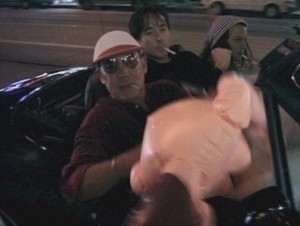
HUNTER S. THOMPSON,JOHNNY DEPP AND JOHN CUCSAK WITH BLOW UP DOLL
Recently, Depp was involved in another adaptation of Thompson’s work called The Rum Diaries. The legitimate novel focuses on a man named Paul Kemp as he explores Puerto Rico as a journalist in the 1950s. It portrays the art of a much younger and conservative H.S.T. who was just beginning to dip into the beauty of Gonzo prose. The DVD version of this film was just release in middle February.

Depp and Thompson
Both films are a testament to the relationship of Johnny Depp and Hunter S. Thomspon. In both roles, as Raul Duke and Paul Kemp, Depp calls upon a great understanding of his author friend to craft characters as believable as they are unbelievable, a special gift Thompson possessed as well. Perhaps this is their greatest compliment, the ability to use the absurd, the uncalled for, and the unaccepted in order to expose a world which normal words and images could not. They challenged the norm and forged their own paths towards greatness.
And less we forget, when Thompson passed away in 2005, Depp financed the entire affair. An affair which happened to include the ashes of Dr. Gonzo being launched out of a gigantic cannon atop a 150 ft tower with Bob Dylan’s Mr. Tambourine Man playing alongside red green and white fireworks. If that’s not a funeral I don’t know what is.
“I feel him every single day. Literally, from the time I wake up and have coffee to when I plop my head down on the pillow, I’m haunted by him. And I’m ecstatic for it. I was very fortunate back then to know that whatever was going on, whatever was happening with us, whatever we were doing, I knew it was really special, and I knew that was never going to happen again. I’m very lucky.”
-Johnny Depp
0.000000
0.000000








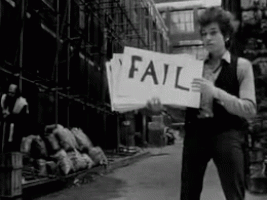
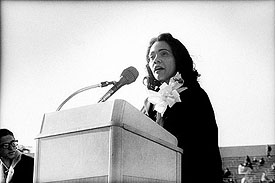

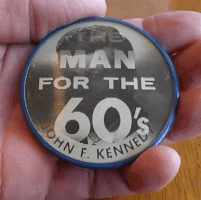






















 :.
:.








